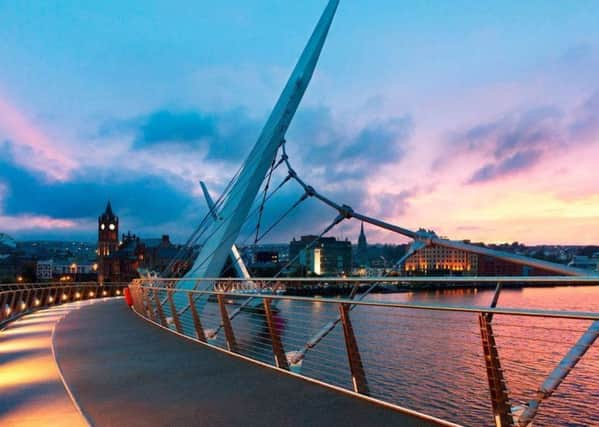Ask yourself: Why is Derry so poor and why is nothing being done about it?


Derry has suffered the highest unemployment of any UK city for years - with a current rate more than twice the Northern Irish average (7.9% versus 3.8%).
The city also has the highest male and female unemployment in NI - with barely half our total adult population in work, a staggering two-thirds of our unemployed being men and almost half of Derry’s claimants (49%) being long-term unemployed (compared to the NI and UK averages of 33% and 31%).
Advertisement
Hide AdAdvertisement
Hide AdWhilst the city has registered a 9% year-on-year fall in its unemployment rate, that decrease has been slower than for other parts of NI with traditionally high unemployment.
Two other constituencies (Belfast West and Belfast North) have, until recently, been Top 10 UK unemployment hotspots along with Foyle, but no longer. Belfast West still has NI’s second-highest unemployment - but at 6.3%, it is significantly lower than Foyle. And it has also been one of the UK’s most improved, with a 15% annual decrease and a 25% drop in youth unemployment.
Meanwhile, Belfast North now has an unemployment rate of 5.8% - a 14% year-on-year improvement. So, whilst unemployment across NI is reducing, Derry is starting from a higher level and improving at a slower rate – widening the gap between us and everywhere else.
For those who are in work in the Derry-Strabane area, the gross weekly median wage is only £324 (versus £393 across NI). The city also has an extremely high reliance on public sector employment - with 1 in 3 jobs here public sector, compared to just over 1 in 4 across NI. And 43% of the Derry-Strabane district’s population live in Northern Ireland’s most deprived areas. So, on wages, jobs and unemployment, the evidence is clear – Derry is not only at the bottom of the pile but is increasingly being left behind.
Advertisement
Hide AdAdvertisement
Hide AdConsultancy firm PWC publishes an annual UK ‘Good Growth for Cities’ report to rank places according to economic well-being. Their 2017 report put Belfast mid-table of the UK’s 57 cities in terms of economic health but ranked Derry bottom - identifying it as one of only two cities not to see any improvement since 2013.
PWC concluded: “The city has not seen reductions in unemployment on the same scale as its peers and has seen worsening scores in areas such as health, work-life balance and income equality”.
Levels of entrepreneurial activity offer an insight into the health of any economy, with a ‘Global Entrepreneurship Monitor’ measuring entrepreneurial likelihood. Whilst the UK has seen record levels of new business start-ups recently, Northern Ireland has its lowest entrepreneurship - with only 6.3% of working-age population engaged in business start-up, versus an 8.8% UK average.
NI’s headline figure masks significant internal differences, however – with Mid-Ulster the highest at 6.6% and Derry/Strabane the lowest at only 4.2%.
Advertisement
Hide AdAdvertisement
Hide AdThe rate of male entrepreneurial activity in Mid-Ulster was more than double that of Derry, whilst only 2% of 18-29-year-olds locally are engaged in entrepreneurship - three times below the NI average.
And, with graduates twice as likely as non-graduates to start their own business, these figures are, in part, an outcome of Derry’s minimal higher education provision.
Of the 15 towns and cities in Ireland that offer Higher Education places, Derry has, by far, the lowest provision. UU Magee’s 4,000 student places amount to less than 4% of its local population - versus 34% in Galway (26,000 places), 30% in Limerick (27,000), 21% in Coleraine (5,500) and 14% in Belfast.
Assurances are received regularly from Ulster University that they intend to expand Magee, but their actions suggest otherwise – like their decision to relocate 16,000 students and staff from Jordanstown to Belfast rather than Derry.
Advertisement
Hide AdAdvertisement
Hide AdMeanwhile, more than a third of people in Derry have no qualifications at all, whilst the figure for Strabane is 40% (both significantly above the 24% NI average).
Derry has one of the youngest populations in Europe, and some of the best schools in Northern Ireland. However, large numbers of our city’s brightest depart every year to study with insufficient Uni places to replace them with an influx from elsewhere.
A survey last year found that 95% of Derry’s young people see no future for themselves locally - 40% blaming a lack of employment, whilst 21% plan to depart for University.
Derry also has the highest percentage of schoolchildren entitled to free school meals in Northern Ireland (43.3% vs NI average of 30.7%).
Advertisement
Hide AdAdvertisement
Hide AdAnd a 2017 report from the Western Health Trust showed that one in three local children are being raised in poverty (the highest in NI).
Whilst recent years have seen Northern Ireland climb off the bottom of the UK’s house price index, Derry is again being left behind.
It has the second cheapest housing of any city in the UK, with an average price of £117,989 – a quarter below the NI average.
Despite property being cheap here, we manage to have the UK’s lowest home ownership (46% versus an NI average of 62%) and above average levels of social housing (19% vs. 16.5% across NI).
Advertisement
Hide AdAdvertisement
Hide AdIt is clear from all the above statistics that Derry is dwindling at the bottom of the economic pile in Northern Ireland.
And whilst the rest of the north continues to converge with the UK economically, we are being firmly left behind.
Next week’s article will consider how Derry has found itself in such a precarious economic position.
Steve Bradley is a commentator and urban regeneration consultant. He can be followed on Twitter : @Bradley_Steve